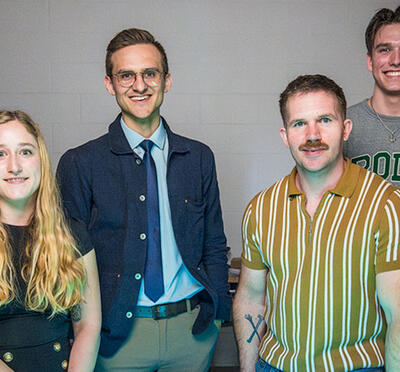Ronald L. Anderson, CEO and co-founder of the A&K Development Co., talks to School of MIME mechanical engineering graduate student Tim Foglesong at the A&K facility in Eugene, Oregon.
Eugene Equipment Manufacturer Benefits from Virtual Design
For more than three decades, Ron Anderson, owner and founder of the A&K Development Co. based in Eugene, Oregon, has been building and selling food processing machines.
Based on his years of experience in the food processing industry, Anderson and his partner Tom Kessler – the K of A&K – invented a corn-husking machine that would use less floor space, be easier to maintain, operate automatically, and damage fewer kernels.
“Customers could pretty much pay for the machine with the greater yield, and less loss to shelling," Anderson said, explaining that shelling is the professional term for wasted corn kernels.
After years of trial and error, Anderson and Kessler had their first husker ready in August 1979. Anderson drove it to Fairwater, Wisconsin to show a local food processor, mildly interested in the contraption. The machine worked flawlessly and A&K had its first sale. By 1982, with six employees, the company produced and sold 62 huskers.
Today, A&K manufactures and sells food-processing equipment and has more than 90 percent of the worldwide market for corn husking machines. After causing a paradigm shift in the sweet corn industry, A&K developed a gentler husker for seed corn, now its biggest market. A&K equipment is found around the globe, with promising growth in South America, China, and Eastern Europe.
While paging through a trade magazine in December of 2012, an article about Oregon State’s School of Mechanical, Industrial, and Manufacturing Engineering (MIME) research focused on computerized machine building and testing caught Anderson’s eye. He contacted the school, had a few discussions, and soon funded a research and development project to analyze A&K’s vibratory shaker that feeds ears of corn to the husking machine.
The Oregon Metals Initiative is matching A&K’s funding for the project.
The effort is a top-tier “Large Scope Analysis or Design Project” with MIME graduate student Tim Foglesong under the supervision of Dr. John Parmigiani and Dr. Rob Stone.
“When I am engineering something, my idea is to make it simple. As soon as someone says to me, ‘well, that’s simple, anyone would have done it that way,’ that’s when I know the machine is ready,” Anderson said.
The processes for designing and building machines, however, are anything but simple. Anderson’s project has roots in MIME’s Complex Engineered System Design Laboratory. In theory, a new machine would perform exactly as a computerized model of each part and each movement predicted.
“For my needs – A&K is selling machines that must perform during harvest time. I need to know how many hours are expected before a part wears out, and if the part is performing as it needs to. I can then provide better service to my customers,” Anderson said.
The School of MIME's failure-analysis research process has been funded by DARPA for military systems development in past years. Other institutions researching the concept include Vanderbilt University, the Massachusetts Institute of Technology, Georgia Tech University, Palo Alto Research Center, and Carnegie Mellon University.
For A&K, Foglesong will collect the necessary weight, spring force, and shock-absorbing values from the parts that control the machine's movement, and create a mathematical model that predicts how much the pan on the shaker table will vibrate.
"I am developing a dynamic model using the masses of the pan and counterweight – the moving parts – spring constants of both the suspension and drive springs, and damping in the pan / counterweight suspension," Foglesong said.
"I can plug these values and the sinusoidal forcing function provided by the motor into a differential equation with initial position, velocity, and acceleration values. I can then solve the equation numerically with a computer to obtain a prediction of how the pan and counterweight will vibrate when driven at a specific motor speed," Foglesong said.
"Later, I will use this model for a model-based optimization, where different spring values, pan weights, etc. – parts that haven't even been used yet – can be plugged in and the resulting vibration of the pan can be predicted. The computer model can also be used to optimize a spring value or pan weight for a desired performance characteristic," Foglesong said.
There are other expectations, too. Anderson's latest corn husking machine delivered a major improvement in the machine's energy efficiency ratio to previous models.
A&K also manufactures pre-cleaning equipment for numerous root vegetables as well as citrus crops. The shaker table has a patented drive mechanism to move product efficiently during processing.
Anderson would like to develop new equipment and features using the model-based design approach, and get them to market faster and cheaper.



